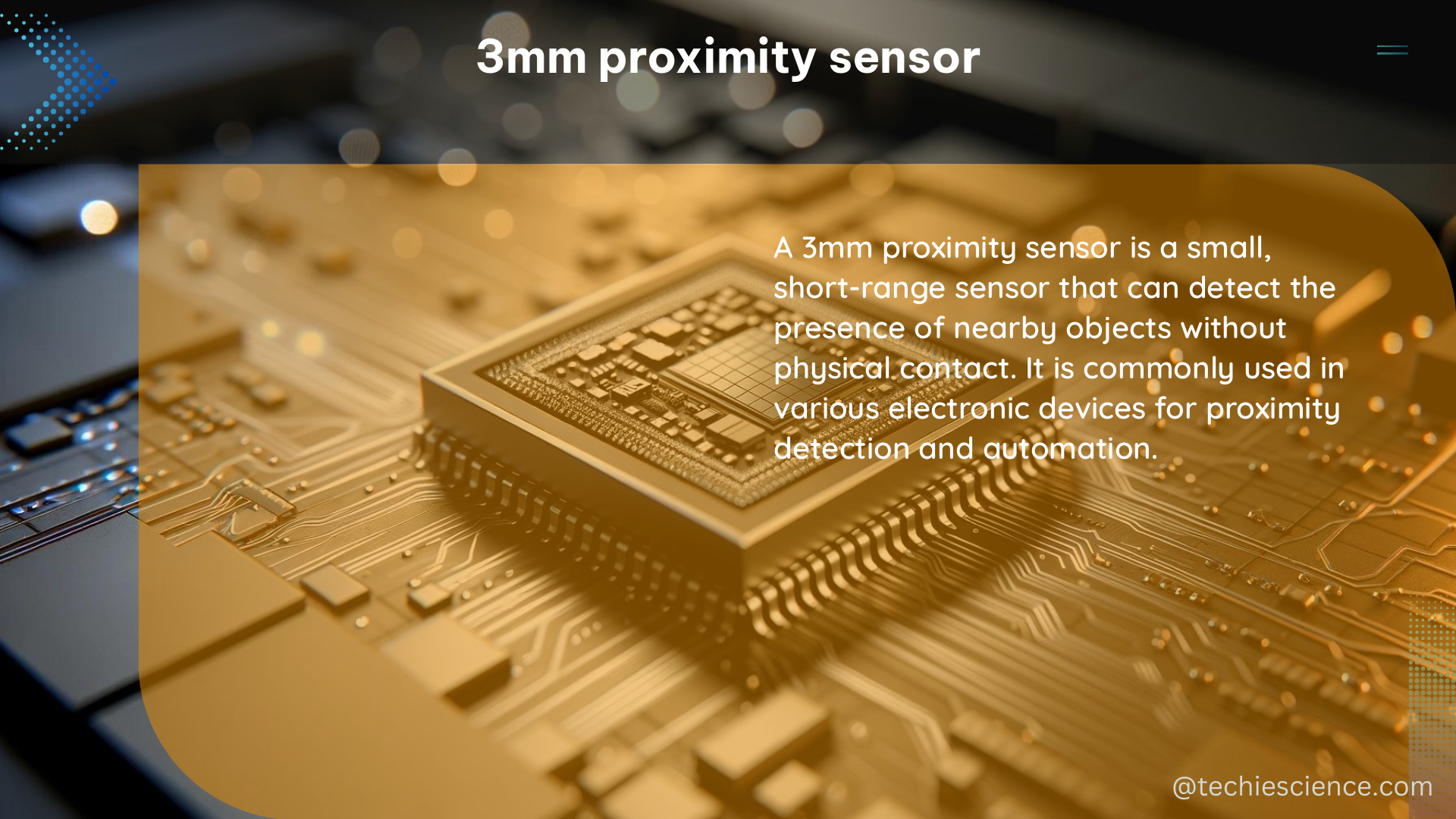The 3mm proximity sensor is a versatile and highly accurate device used in a wide range of industrial, automation, and robotic applications. These compact sensors are designed to detect the presence or absence of objects within a specific range, typically up to 1mm, with a switching frequency of up to 3kHz. Featuring a durable stainless steel housing, 3mm proximity sensors offer reliable performance and long-lasting operation, making them an essential tool for precise object detection.
Understanding the Technical Specifications of 3mm Proximity Sensors
When it comes to 3mm proximity sensors, there are several key technical specifications to consider:
Supply Voltage
The supply voltage for 3mm proximity sensors can range from 10 to 30 volts, depending on the manufacturer and model. This wide voltage range allows for compatibility with a variety of power sources and control systems.
Output Type
3mm proximity sensors can have either NPN or PNP output types, which refers to the type of transistor used in the sensor’s output stage. NPN sensors typically sink current, while PNP sensors source current, making them suitable for different circuit configurations.
Switching Distance
The switching distance, or the distance at which the sensor can reliably detect an object, is a crucial specification for 3mm proximity sensors. Depending on the model, the switching distance can range from a few millimeters to several centimeters, allowing for precise object detection in a variety of applications.
Housing Material
The housing of a 3mm proximity sensor is typically made of stainless steel, providing durability and resistance to environmental factors such as corrosion, impact, and temperature extremes. This robust construction ensures reliable performance and long-term operation in demanding industrial environments.
Sensing Principle
3mm proximity sensors can utilize different sensing principles, such as inductive, capacitive, or photoelectric, depending on the specific application requirements. Inductive sensors, for example, are commonly used for detecting metallic objects, while capacitive sensors can detect both metallic and non-metallic objects.
Switching Frequency
The switching frequency of a 3mm proximity sensor refers to the rate at which the sensor can detect and respond to changes in the presence of an object. With switching frequencies up to 3kHz, these sensors can provide rapid and accurate object detection, making them suitable for high-speed applications.
Integrating 3mm Proximity Sensors into DIY Projects

The versatility of 3mm proximity sensors makes them an excellent choice for a wide range of DIY projects, from home automation to robotics and industrial automation. Here are some examples of how these sensors can be utilized:
Home Automation
In a home automation system, a 3mm proximity sensor can be used to create a simple presence detector. By strategically placing the sensor near doorways or other areas of interest, the system can detect the presence or absence of people, triggering various actions such as turning on lights, activating security systems, or adjusting environmental controls.
Robotics and Industrial Automation
In robotics and industrial automation applications, 3mm proximity sensors can be used to detect the position and movement of objects, such as parts on an assembly line or the position of a robotic arm. This information can be used to control the operation of the system, ensuring precise and efficient operation.
Object Counting and Positioning
3mm proximity sensors can also be used in DIY projects for object counting and positioning. By placing the sensor at key points in a system, you can track the movement and position of objects, enabling applications such as inventory management, quality control, or automated material handling.
Connecting 3mm Proximity Sensors to Microcontrollers
To use a 3mm proximity sensor in a DIY project, you’ll typically need to connect it to a microcontroller or other electronic device that can read the sensor’s output signal and use it to control other devices or systems. Here are some common microcontroller platforms that can be used with 3mm proximity sensors:
Arduino
The Arduino platform is a popular choice for DIY projects, and it can easily interface with 3mm proximity sensors. By connecting the sensor’s output to a digital input pin on the Arduino, you can read the sensor’s state and use it to control other components in your project.
Raspberry Pi
The Raspberry Pi is another popular microcontroller platform that can be used with 3mm proximity sensors. By connecting the sensor to the Raspberry Pi’s GPIO (General-Purpose Input/Output) pins, you can write code in languages like Python to read the sensor’s data and integrate it into your project.
PLC (Programmable Logic Controller)
For more industrial-focused applications, a Programmable Logic Controller (PLC) can be used to interface with 3mm proximity sensors. PLCs are designed for robust and reliable operation in harsh environments, making them well-suited for industrial automation and control applications.
Conclusion
The 3mm proximity sensor is a powerful and versatile tool for precise object detection in a wide range of applications. With its compact size, durable construction, and advanced technical specifications, this sensor can be integrated into a variety of DIY projects, from home automation to robotics and industrial automation. By understanding the key features and capabilities of 3mm proximity sensors, you can unlock new possibilities for your projects and take your DIY endeavors to the next level.
Reference:
- Inductive proximity sensor reading – NI Community
- Collecting digital data from a PNP proximity sensor with Arduino
- Data Tabulation/Recording of Proximity Sensor using Arduino

The lambdageeks.com Core SME Team is a group of experienced subject matter experts from diverse scientific and technical fields including Physics, Chemistry, Technology,Electronics & Electrical Engineering, Automotive, Mechanical Engineering. Our team collaborates to create high-quality, well-researched articles on a wide range of science and technology topics for the lambdageeks.com website.
All Our Senior SME are having more than 7 Years of experience in the respective fields . They are either Working Industry Professionals or assocaited With different Universities. Refer Our Authors Page to get to know About our Core SMEs.